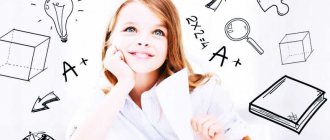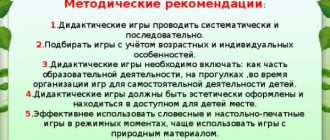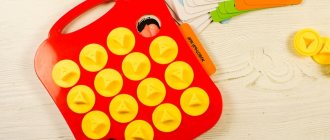Development of memory in preschool children. It is impossible to imagine a mentally healthy person without memory. This simply cannot happen. After all, memory is a tool with which an individual can apply his experience and rely on previously acquired knowledge. It is important to teach your memory to work correctly so that it does not fail. For this, a fertile period will be preschool age, when the emergence and development of mental activity occurs.
Features of memory development in a preschool child
Each time period of a person’s life is different from others, because at each stage new knowledge comes. In addition, the ability to remember depends on a person’s physical and mental abilities. In preschool age, memory is excellent, the child literally grasps everything on the go. Everything he learns interests him; this is the process of cognition. But what seemed uninteresting will remain overboard.
Memory is a meaningful action. If a child does not understand something, he will not remember it. Involuntarily, things that touched and impressed the child are remembered. And in order to remember something that, in a child’s opinion, is not at all interesting, you need to work hard. Meanwhile, the child who is already learning to analyze, compare, generalize, and masters other operations of mental activity remembers better.
Bright pictures are very important for children; their eyes catch colorful illustrations, and their brain forces them to put these images in their memory. Movement also helps memory. A child cannot be passive, so outdoor games and exercises help develop his memory.
The first important stage in the period of growing up of a preschooler appears at the age of four. If before this period there were first actions that gave rise to memorization, then in the middle group of kindergarten the child can already remember the words spoken to him and perform some actions based on instructions. He can even plan some actions himself based on the remembered material, and first of all, the support for these memories will be the child’s personal observations.
At the age of five, a preschooler comprehends logical memorization; adults help him with this when they give some instructions or explanations for any actions. During this period, the interaction of mental operations is important.
Benefit
Games that develop memory are the most popular. This is the leading activity for children, so their enthusiasm is not surprising. But why are they preferred by older and older people? They just have undeniable advantages over the same finger and speech gymnastics, daily exercises, logical puzzles and even mnemonic techniques:
- this is an interesting and exciting process that makes you take your mind off problems;
- it relieves fatigue and tension, combining relaxation and benefits at the same time;
- their rules are usually simple and can be learned by everyone - children, old people, people with disabilities;
- competitive spirit is a good motivation to do everything perfectly and achieve the desired result;
- Team games always mean communication, the ability to find contacts with other people, which also has a positive effect on the development of brain activity, and therefore memory too.
How exactly does play help develop memory?
Rules control the behavior of participants, not allowing them to go beyond what is permitted - they must be constantly kept in mind while simultaneously performing other actions.
Overcoming obstacles and the ability to control your negative emotions in the event of failure or loss contribute to the development of those same neural connections. They force one to draw conclusions about mistakes made - a person remembers them so as not to make them next time.
The game requires you to look for ways to solve a given problem, either as a team or independently. Sometimes conditions change rapidly and unexpectedly, to which you need to adapt just as quickly. The result is the development of creativity, initiative, intelligence, and with them attention, thinking and memory.
Most games require maximum concentration, so they can be used to develop memory and attention at the same time.
The result of regular use of gaming activities as a simulator for memory development is an improvement in mental abilities and cognitive mental processes. This will manifest itself in literally all areas: in everyday life, when you don’t have to once again stand in the store and remember what you should have bought; in studies, when the material will be easily remembered; at work, where you always need to be prompt; in relationships, so as not to forget the wedding anniversary or birthday of a loved one.
Types of memory
Development of memory in preschool children. There are several types of memory.
- motor,
- emotional,
- verbal-logical,
- figurative.
In turn, it is necessary to note involuntary memory, when images and objects are remembered as if by themselves, without any effort, and voluntary, when a diligent process of memorization is underway. Involuntary memory is typical for younger preschoolers. Older preschoolers are already beginning to master voluntary memorization.
Emotional development of a preschooler
Reproduction forms
Forms of reproduction can also be divided into groups.
- The simplest thing is recognition. If a person has seen or heard something before, he will certainly recognize it.
- The second form is memory. For memory it is not important to see the object. It is important to remember its signs.
- The third form is recollection. In this case, remembering can be difficult; in order to remember, you need to make an effort and character.
- The fourth form is forgetting. It is impossible to remember everything all the time. Forgetting is the case when the brain refuses to remember the characteristics of an object or replaces one object or phenomenon with others because recognition is blurred.
In preschoolers, figurative memory dominates. He remembers the signs of an object and phenomenon, if they are vivid and catch his imagination. Can remember minor details, but most importantly, forget important things.
In addition, when working with children, you need to remember another feature of the children's brain: selectivity. Everything that is interesting to a preschooler is remembered without difficulty. Everything that is boring and uninteresting is immediately forgotten, because there is no fixation on its main features.
The third feature: repetition is the mother of learning, teachers say following the author of the historical phrase. If a child repeats the same actions over and over again, he automatically remembers.
The fourth distinctive feature of a preschooler’s memory is that emotional influence leads to memorization. What touches you cannot help but leave a trace in your memory.
When the amount of information accumulates, with the development of perception, the child is able to master coherent and systemic ideas. And the next step will be meaningful operation of the acquired knowledge.
Norms of memory development in preschoolers
For a specific age stage there are different norms.
- Up to a year - motor memory, there are reflexes, memorization at the level of emotions.
- 1-2 years – development of the nervous system, figurative memorization.
- 2-4 years – development of mechanical memory, memorization and logical thinking skills, recognition predominates, interest is important for memorization.
- 4-5 years – involuntary memorization, voluntary begins, recall prevails.
- 5-7 years - arbitrary. The volume of normal memorization is from 8 out of 10 items.
Developmental techniques for children
Game 2. Tag
Tag is a great way to exercise your brain! The game of tag is a square board divided into 16 equal square sections. You have 15 square dominoes at your disposal, numbered accordingly. The dominoes themselves are randomly mixed inside the box.
The essence of this game is to put the dominoes in order, namely to place the numbers one after another from top to bottom, from left to right, therefore, the empty square should be from the bottom to the right. The game will help you develop logical thinking and memory, because it is useful to remember various tricks and combinations. You will also be able to develop the ability to calculate moves ahead without making mistakes. Shall we play?
How to measure a child's memory
Development of memory in preschool children. You can measure your child's memory using special tests.
Visual memory
The child is invited to look at the pictures. It will take one and a half minutes to open. Then the child is asked to draw from memory what he saw.
If the child correctly drew most of the objects, his memory is good. If not, there are memory problems.
Another option is to show the child pictures, ten in total. Then they ask him to name the objects he saw.
If the child correctly named more than 8 pictures, his memory is good. If you made a mistake about five times, the result is average. If you made more than five mistakes, then your memory is bad.
Auditory memory
The teacher calls out the numbers, the child must repeat after him. If the child names at least 5 numbers from a series correctly, then his memory is good.
Recognition test
The child is shown a picture depicting certain objects. Then he is asked to find these objects in a large picture.
If a child managed to find at least eight out of 10 objects, his memory is good. Made more than five mistakes - the result was weak.
Exercises and games to develop memory
Remembering that it is easier for a preschooler to remember things that he understands, you need to build the learning process through play, based on motor activity and emotions caused by interest.
Development of figurative memory
Development of memory in preschool children. The child’s ability to involuntarily memorize objects can be used in the “Classification” game. In this case, the child is offered several pictures with images of some objects. The child needs to arrange the illustrations into groups. For example, he must arrange pieces of furniture into “rooms”: bedroom, living room, kitchen, bathroom. Or there are pictures of animals. The child should put domestic animals in the “house” and wild animals in the “forest”.
The game “Shop” will help to develop figurative memory. The child shopper “does” the shopping, who must put into a basket the items he was told to “buy.”
Development of imagination in preschool children
Development of auditory memory
When a child hears some information, he mentally processes it and only then takes action. What if the child does not know how to listen and hear? Then there is no need to talk about his future success at school. Therefore, it is very important for preschoolers to develop auditory memory. You can use these exercises.
Verbal relay race
In this game, the leader names a word. The child must repeat the word that the leader said and say his own word. Then it’s the presenter’s turn. He names these two words and adds a third. Child's turn: he repeats all the words and adds a fourth word. It is desirable that the words be on a specific topic: “Summer”, “Vegetables”, “Transport”, “Dishes”, etc. The one who made a mistake, knocked down the verbal chain, lost.
Game of colors
In this exercise, the child must color the picture. But before that, he listens to a text passage that talks about the plot in the picture and names the colors. For example, in the picture there is a house with a brown roof, red apples grow on the tree house, and blue flowers grow in the clearing. In order to color the picture correctly, the child must remember the text.
Tact
Clap your hands or knock with a hammer, beating time. The child must repeat the sound combination.
Auditory Memory Training
Despite the fact that the famous Russian proverb states that “it is better to see once than to hear 100 times,” auditory memory can sometimes be no less useful. Thus, without auditory memory it is difficult for musicians, actors, politicians and even intelligence officers to achieve success. To understand how important auditory memory is, remember that listening to a lecture is remembered better than just reading a textbook or viewing slides.
The peculiarity of auditory memory is that, unlike visual impressions, which are perceived more quickly, memory often retains well-remembered auditory impressions better. Below are some techniques and methods that will help you learn how to effectively remember auditory information.
Exercise 1: Reading aloud
Reading aloud is undoubtedly one of the most effective exercises for developing auditory memory. It is reading aloud that helps to increase working vocabulary, improve diction, intonation, emotional coloring and brightness of speech. Reading aloud helps us better remember the auditory components of the material we read.
You need to read aloud slowly, at an optimal conversational pace, observing some technical nuances:
- pronounce words clearly, expressively and with placement;
- pronounce the text not monotonously, but as if you were expressing your own thoughts (telling).
If you read aloud for at least 10-15 minutes every day, then within a month you will notice obvious results in both your speaking abilities and your auditory memory.
Exercise 2. Poems
Memory training does not have to be limited to any specific exercises. Make it a habit to memorize a short poem every day, or at least every week. Try to delve deeply into its meaning, think about the techniques that the poet used.
When learning a poem, you will repeat it either out loud or silently, using your articulation apparatus. The more repetitions you do, the better your memory will remember the poem. Over time, you will train your memory and begin to memorize verses as a result of much less repetition.
In addition, the poems themselves are often used for long-term memorization of any abstract information. You can see the applied use of the method in some materials on our website, which describe the principles of memorizing information such as:
- Numbers after the decimal point in Pi;
- Multiplication table.
Exercise 3. Eavesdropping
When walking down the street or while on public transport, try to hear and retain in your memory a fragment of a conversation between strangers. Then try to reproduce to yourself what you heard with the right intonation, and also mentally imagine the faces of the people who said it. This exercise allows you to learn to comprehend text fluently by ear, and will also allow you to be more attentive and sensitive to the tone of speech.
Statistics Full screen
Development of visual memory
Development of memory in preschool children. Bright pictures attract children's attention, but are kids able to retain the image in memory? To develop their abilities, you can invite preschoolers to play the following games:
"Restore the pattern"
A pattern is laid out on the surface using painted parts. The child remembers it. Then the child is asked to lay out the same pattern from memory.
"Scout"
There are objects on the table. The child looks at them and remembers what and where it is. Then the child turns away, and some objects are swapped. The child must name the objects that were moved.
"Walk"
While walking, the child sees many colors and objects, he involuntarily remembers what attracted his attention. An adult should help focus attention. After the walk, you can ask your child to draw what he remembers.
"Photo report"
Prepare a picture in advance, for example this one.
Action plan:
- Show your child a picture and invite him to “take a photo” of it with his inner “camera.”
- After 30 seconds, remove the picture.
- Ask your child to answer the questions.
Questions for our sample could be the following:
- How many shelves are hanging on the wall?
- What is written on the bed linen?
- Who's lying on the bed?
- What color is the wardrobe and bedside tables?
- What's on the windowsill?
- What time is on the clock?
- Where does the turtle sit?
- How many lamps are there in the room?
- What color are the curtains?
- Is there a violin in the room?
There are a lot of similar exercises in children's magazines.
Development of motor memory
To develop motor memory, you can play “puppet”. The child stands calmly, and the adult controls his arms and legs, forcing him to go right, left, forward. Then the child is asked to repeat the movements from memory.
You can also use the game “Do as I do.” The teacher makes the movements, the child repeats after him.
Developmental activities for preschool children
Development of arbitrary logical memory
The ability to classify leads to the development of arbitrary logical memory, so it is important to give children exercises where they must use methods of classification, analysis, comparison and generalization.
Didactic game "Cards"
Children are asked to select images based on specific characteristics and arrange them in piles. For example, from pictures with birds and animals, you need to put pictures with birds in one group, and pictures with animals in another. Themes for the game can be different: sports, furniture, seasons, plants, etc.
"Twins"
Among different pictures, the child must find two identical ones.
Development of long-term memory
Development of memory in preschool children. To develop long-term memory, you need to teach a child not only to recognize, but also to reproduce information. Long-term memory is impossible without expanding the horizons of a preschooler. In this case, exercises with texts and illustrations help.
Preschoolers are offered several pictures depicting animals and various objects. And there is a suggestion: remember all the animals, for example. Or remember all the dishes that are in the pictures and then name them.
A good option would be to compare pictures that differ in minor details.
conclusions
A child’s memory is constantly improving throughout preschool age. Initially involuntary and mechanical memorization gradually becomes a conscious process, and the volume of memory increases. The adult’s task is to help the child maximize his abilities in a playful way. Using the games we describe, you can develop your child’s auditory, visual, tactile and motor memory. But do not forget that childhood is a carefree, happy time, and there is no need to overload your child with constant exercises.
Methods for developing tactile memory
Tactile memory is a person’s ability to remember the sensations of touching a particular object. To develop tactile memory you will need the following exercises:
"Find by touch"
The child is asked to choose one from a variety of objects based on specific tactile characteristics. For example, a child is told that this object is soft and fluffy. Or rough, prickly.
"Game with mood"
The child has associations about objects. If an object is soft and pleasant to the touch, then this object is in a good mood. Which object is in a sad mood? Or evil? The child, relying on tactile sensations, selects objects.
"Tales with tactile details"
In this case, the child participates in a theatrical production, where the plot of a fairy tale is heard, and all the characters and objects surrounding them can be touched and determined what they are: soft, rough, hard, prickly, etc.
Games to develop fine motor skills in children
Game 11. Diamonds
The game "Diamonds" develops memory. The main essence of the game is to remember the order of the figures that light up on the screen and repeat it. There are figures on the screen, they light up one by one, you need to remember the order in which these figures light up, and repeat it. With each subsequent stage of the game, the game becomes more complicated, new figures are added in larger quantities.
Pay close attention to the order in which the figures are lit. Using the mouse or keyboard, you can click through all the figures in order. If you answered correctly, then you continue to score points and play further.
Play now
Memory impairments and their causes
Experts distinguish two main types of disorders:
- quantitative,
- quality.
Quantitative disorders are a weakening of memory, loss of any fragments. With high-quality ones, false memories and fantasies come first, replacing reality.
The causes of memory impairment in children can be:
- mental retardation, often congenital,
- trauma, physical or mental,
- an atmosphere that is not comfortable for the child, where fear displaces everything from the child’s head,
- soreness of the body, including vitamin deficiency.
Developing a baby's associative memory
- “I know five... ” The game is to repeat the name of something while hitting the ball. For example: “I know five cities: Moscow one, St. Petersburg two, Vologda three... and so on.”
- "Name a couple" . Give your child 5-6 pairs of words that are related to each other in meaning (for example, soup - spoon, winter - snow, TV - cartoons). Then ask your child to remember the second word from each pair in response to the first. Gradually the number of word pairs can be increased.
What affects the development of memory in a child
Development of memory in preschool children. In order for a child’s memory to develop, you need to pay attention to the following factors:
Nutrition
The diet should be varied, healthy foods and vitamins should be included in the diet. There must be meat and vegetable products, fish, herbs, and fruits.
Healthy eating: menu for every day
Healthy lifestyle
There must be a daily routine in which you need to devote time to both walks and useful activities. The child should go to bed at a specific time and get up at a specific time. Let the child participate in a sports section or attend a development club.
Development taking into account the age characteristics of the child
Parents must understand that the child must direct his energy in the right direction. However, you should not overtire your preschooler, otherwise you may end up with constant fatigue syndrome. It’s good if developmental classes take place in a kindergarten. It is impossible to overwork a child by enrolling him in several sections and clubs at once.
Exercises for memory development in children: VIDEO
Training memory and attention in adults - the best exercises
Classes to improve memory in adults are not such a difficult task. If you wish, you don’t have to waste extra time on training attention in adults. Listen carefully to your friend, trying to remember the color of his shirt, shoes, coat, eyes, hair. After you part, try to remember these colors.
While walking down the street, try to remember the numbers of buses or cars passing by. If you are stuck in a traffic jam or have a long ride on a trolleybus, solve crosswords and scanwords
They are great for training memory and attention.
Memorize three words of a foreign language every day. Learn poetry, read at least 20 pages a day. These simple ways train the brain and memory of busy adults.
Try not to overwork and eat right. Fresh fruits and vegetables, greens, a lean diet, enough calories, a varied menu are necessary to nourish brain cells.







